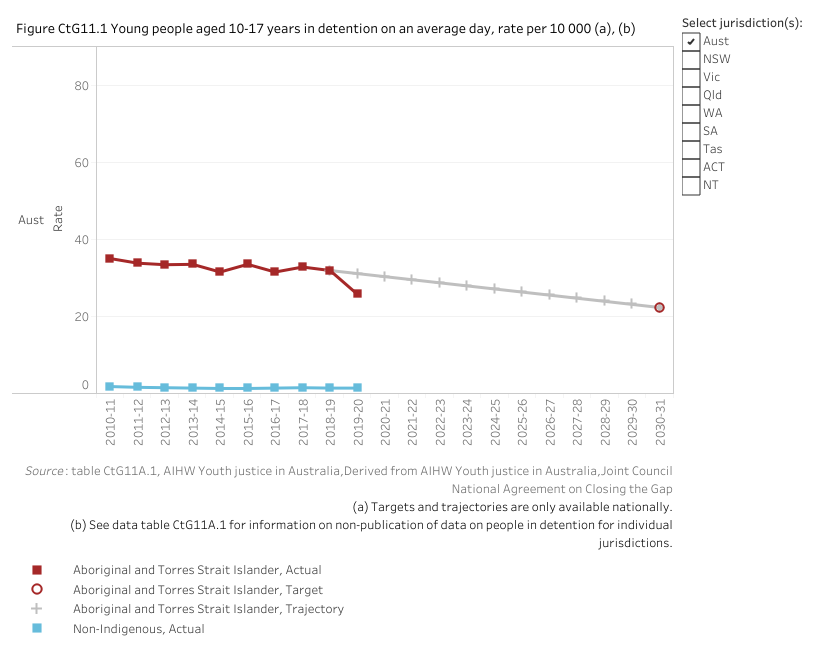TARGET 11
By 2031, reduce the rate of Aboriginal and Torres Strait Islander young people (10-17 years) in detention by at least 30 per cent
Dashboard snapshot: The data below are the most recent at the time of preparing the July 2021 report. Please go to the dashboard to access the current data.
Nationally in 2019-20, the rate of Aboriginal and Torres Strait Islander children aged 10-17 years in detention was 25.7 per 10 000 children in the population (figure CtG11.1).
This is a decrease from 31.9 per 10 000 young people in 2018-19 (the baseline year).
Nationally, based on the most recent year of data, this target is on track to be met.

The assessment below reflects progress from the baseline year to the current year (ie improvement or otherwise in the rate). This differs to the national assessment against the trajectory (above), which compares the current year rate to the rate on the target trajectory at the same time period.
Target data specifications
Outcome: | Aboriginal and Torres Strait Islander young people are not overrepresented in the criminal justice system. |
|---|---|
Target: | By 2031, reduce the rate of Aboriginal and Torres Strait Islander young people (10–17 years) in detention by at least 30 per cent. |
Indicator: | The rate of Aboriginal and Torres Strait Islander young people aged 10–17 years in detention. |
Measure: | This measure is defined as: Numerator — average daily number of Aboriginal and Torres Strait Islander young people aged 10–17 years in supervised youth detention Denominator — number of Aboriginal and Torres Strait Islander people aged 10–17 years in the population and is presented as a rate per 10 000 children. |
Target established: | National Agreement on Closing the Gap July 2020 |
Latest dashboard update: | 23 June 2021 |
Indicator type: | Target |
Interpretation of change: | A low or decreasing rate is desirable. A decrease from the baseline year is an improvement. |
Data source(s): | Name (numerator): Youth Justice National Minimum Dataset (YJ NMDS) Frequency: Annual Name (denominator): Estimates and Projections for Aboriginal and Torres Strait Islander population Frequency: Annual (data revised on a five-yearly basis) Documentation (links): https://www.aihw.gov.au/reports-data/health-welfare-services/youth-justice |
Data provider: | Provider name (numerator): Australian Institute of Health and Welfare Provider area: Youth justice Provider name (denominator): Australian Bureau of Statistics Provider area: Demography |
Baseline year: | 2018-19 (data revised 2021) |
Target year: | 2030-31 |
Disaggregations: | State and territory and Australia, by Indigenous status. |
Computation: | Numerator divided by Denominator multiplied by 10 000 Counting rules Age is calculated based on the age a young person is each day that they are under supervision. If a young person changes age during a period of supervision, then the average daily number under supervision will reflect this. Historical data have been revised to reflect this methodology. The numerator is calculated by summing the number of days each young person spends in detention during the financial year and dividing this total by the number of days in the financial year reporting period. Rates are calculated from unrounded numbers of young people on an average day. Includes (numerator):
Excludes (numerator):
Denominator:
|
Data quality considerations: | Data by Indigenous status are influenced by the quality of Aboriginal and Torres Strait Islander identification of young people in the YJ NMDS. About 5 per cent of all young people in the YJ NMDS since 2000-01 have an unknown Indigenous status. In 2018-19, less than 2 per cent of all young people under supervision during the year had an unknown Indigenous status. Among the states and territories, this ranged from less than 1 per cent in Victoria, Queensland and South Australia to 5 per cent in New South Wales. Western Australia and the Australian Capital Territory had no unknown Indigenous status. Rates are not provided by the AIHW where the numerator is less than five. However, relevant data are included in the calculation for Australian totals. Each year, most jurisdictions supply historical data to the most recent financial year, incorporating updates to data as required. Trend data may therefore differ from those published previously due to data revisions. |
Future reporting: | Additional disaggregations required for future reporting:
|
Supporting indicators
Driver
- Un-sentenced detention rates
- Average time in detention for unsentenced youth
- Proportion of young alleged offenders (10-17 years) involved in police proceedings
Including charges and summons, cautions, diversions - Proportion of young people convicted and sentenced
By type of sentence (community supervision, detention) - Entrant rate to detention
Newly sentenced to youth detention - Proportion of youth under community supervision transitioning to detention
- Young people returning to detention or community supervision
- Proportion of young people first coming into youth justice system aged 10-13
Offending and courts data, first entry to detention
Contextual information
- Community supervision trends
Proportion of young people in detention who had received child protection services (including out-of-home care) - Proportion exiting detention
By reason - Progress towards parity
